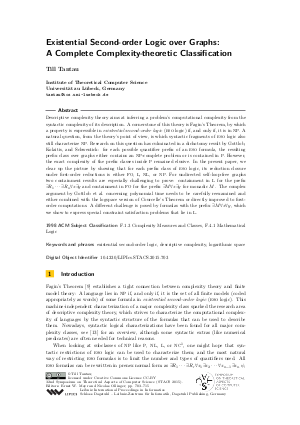Existential Second-order Logic over Graphs: A Complete Complexity-theoretic Classification
Author Till Tantau
-
Part of:
Volume:
32nd International Symposium on Theoretical Aspects of Computer Science (STACS 2015)
Part of: Series: Leibniz International Proceedings in Informatics (LIPIcs)
Part of: Conference: Symposium on Theoretical Aspects of Computer Science (STACS) - License:
 Creative Commons Attribution 3.0 Unported license
Creative Commons Attribution 3.0 Unported license
- Publication Date: 2015-02-26
File

PDF
LIPIcs.STACS.2015.703.pdf
- Filesize: 0.64 MB
- 13 pages
Document Identifiers
Subject Classification
Keywords
- existential second-order logic
- descriptive complexity
- logarithmic space
Metrics
- Access Statistics
-
Total Accesses (updated on a weekly basis)
0Document
0Metadata
Abstract
Descriptive complexity theory aims at inferring a problem's computational complexity from the syntactic complexity of its description. A cornerstone of this theory is Fagin's Theorem, by which a property is expressible in existential second-order logic (ESO logic) if, and only if, it is in NP. A natural question, from the theory's point of view, is which syntactic fragments of ESO logic also still characterize NP. Research on this question has culminated in a dichotomy result by Gottlob, Kolaitis, and Schwentick: for each possible quantifier prefix of an ESO formula, the resulting prefix class over graphs either contains an NP-complete problem or is contained in P. However, the exact complexity of the prefix classes inside P remained elusive. In the present paper, we clear up the picture by showing that for each prefix class of ESO logic, its reduction closure under first-order reductions is either FO, L, NL, or NP. For undirected self-loop-free graphs two containment results are especially challenging to prove: containment in L for the prefix \exists R_1\cdots \exists R_n \forall x \exists y and containment in FO for the prefix \exists M \forall x \exists y for monadic M. The complex argument by Gottlob et al. concerning polynomial time needs to be carefully reexamined and either combined with the logspace version of Courcelle's Theorem or directly improved to first-order computations. A different challenge is posed by formulas with the prefix \exists M \forall x\forall y, which we show to express special constraint satisfaction problems that lie in L.
Cite As Get BibTex
Till Tantau. Existential Second-order Logic over Graphs: A Complete Complexity-theoretic Classification. In 32nd International Symposium on Theoretical Aspects of Computer Science (STACS 2015). Leibniz International Proceedings in Informatics (LIPIcs), Volume 30, pp. 703-715, Schloss Dagstuhl – Leibniz-Zentrum für Informatik (2015)
https://doi.org/10.4230/LIPIcs.STACS.2015.703
BibTex
@InProceedings{tantau:LIPIcs.STACS.2015.703,
author = {Tantau, Till},
title = {{Existential Second-order Logic over Graphs: A Complete Complexity-theoretic Classification}},
booktitle = {32nd International Symposium on Theoretical Aspects of Computer Science (STACS 2015)},
pages = {703--715},
series = {Leibniz International Proceedings in Informatics (LIPIcs)},
ISBN = {978-3-939897-78-1},
ISSN = {1868-8969},
year = {2015},
volume = {30},
editor = {Mayr, Ernst W. and Ollinger, Nicolas},
publisher = {Schloss Dagstuhl -- Leibniz-Zentrum f{\"u}r Informatik},
address = {Dagstuhl, Germany},
URL = {https://drops.dagstuhl.de/entities/document/10.4230/LIPIcs.STACS.2015.703},
URN = {urn:nbn:de:0030-drops-49524},
doi = {10.4230/LIPIcs.STACS.2015.703},
annote = {Keywords: existential second-order logic, descriptive complexity, logarithmic space}
}
Author Details
References
-
Eric Allender, Michael Bauland, Neil Immerman, Henning Schnoor, and Heribert Vollmer. The complexity of satisfiability problems: Refining Schaefer’s theorem. Journal of Computer and System Sciences, 75(4):245-254, 2009.

-
Egon Börger, Erich Grädel, and Yuri Gurevich. The Classical Decision Problem. Springer-Verlag, Berlin, 1997.

-
Julius R. Büchi. Weak second-order arithmetic and finite automata. Zeitschrift für mathematische Logik und Grundlagen der Mathematik, 6:66-92, 1960.

-
Stephen A. Cook and Pierre McKenzie. Problems complete for deterministic logarithmic space. Journal of Algorithms, 8(5):385-394, 1987.

-
Bruno Courcelle. The monadic second-order logic of graphs. I. Recognizable sets of finite graphs. Information and Computation, 85(1):12-75, 1990.

-
Thomas Eiter, Georg Gottlob, and Yuri Gurevich. Existential second order logic over strings. Journal of the ACM, 47(1):77-131, 2000.

-
Michael Elberfeld, Martin Grohe, and Till Tantau. Where first-order and monadic second-order logic coincide. In Proceedings of the 27th Annual ACM/IEEE Symposium on Logic in Computer Science (LICS 2012), pages 265-274. IEEE Computer Society, 2012.

-
Michael Elberfeld, Andreas Jakoby, and Till Tantau. Logspace versions of the theorems of Bodlaender and Courcelle. In Proceedings of the 51st Annual IEEE Symposium on Foundations of Computer Science (FOCS 2010), pages 143-152, 2010.

-
Ronald Fagin. Generalized first-order spectra and polynomial-time recognizable sets. Complexity of Computation, 7:43-74, 1974.

-
Stéphane Földes and Peter L. Hammer. Split graphs. In Proceedings of the Eighth Southeastern Conference on Combinatorics, Graph Theory and Computing, Congressus Numerantium XIX, pages 311-315. Louisiana State Univeristy, Baton Rouge, Louisiana, 1977.

-
Georg Gottlob, Phokion G. Kolaitis, and Thomas Schwentick. Existential second-order logic over graphs: Charting the tractability frontier. Journal of the ACM, 51(2):312-362, 2004.

-
Edith Hemaspaandra, Holger Spakowski, and Mayur Thakur. Complexity of cycle length modularity problems in graphs. In Proceedings of the 6th Latin American Symposium on Theoretical Informatics (LATIN 2004), volume 2976 of Lecture Notes in Computer Science, pages 509-518. Springer, 2004.

-
Neil Immerman. Descriptive Complexity Theory. Springer-Verlag, New York, 1998.

-
Neil Robertson and P. D. Seymour. Graph minors. II. Algorithmic aspects of tree-width. Journal of Algorithms, 7(3):309-322, 1986.

-
Thomas J. Schaefer. The complexity of satisfiability problems. In Proceedings of the 10th Symposium on Theory of Computing (STOC 1978), pages 216-226. ACM Press, 1978.

-
Till Tantau. Existential second-order logic over graphs: A complete complexity-theoretic classification. Technical Report arxiv:1412.6396 [cs.LO], ArXiv e-prints, 2014.

